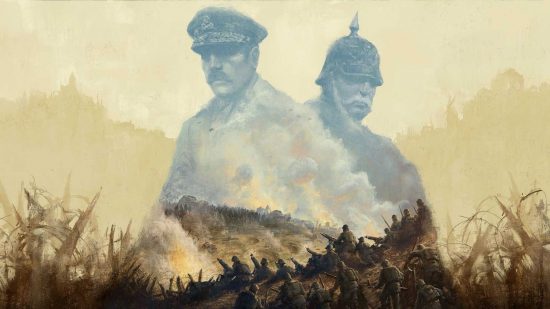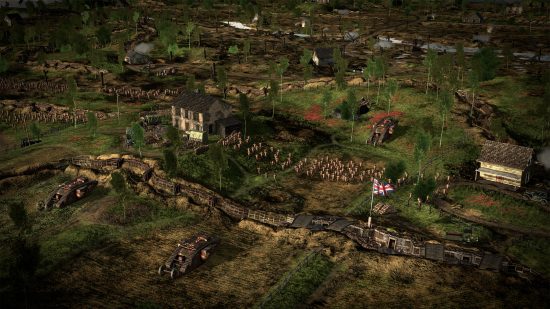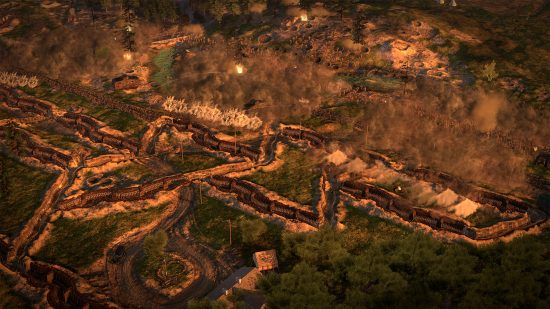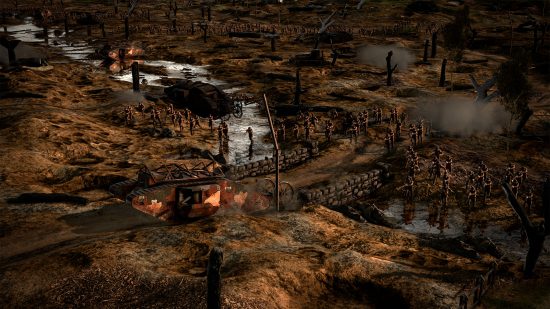When Petroglyph Games showed me its new RTS game The Great War: Western Front at Gamescom 2022, I thought: I know exactly what to do differently. I then felt a sting of shame at the arrogance of imagining I could do better than the best commanders of the time, but it’s an attitude engendered by the way we teach the war, and by Petroglyph’s invitation to play through it ourselves.
World War 1 was a fixture of my education. In English we studied the poetry it inspired for several years – it certainly felt that way, at least – and in history, I did a big project on the new weapons unleashed by industrialisation and the challenge they posed to traditional tactics. This left my teenaged self with a widely held view of the war: that its tragedy lay not only in the sheer scale of the loss of life, but in its avoidability. If only the generals had been more adaptable, more aware of conditions at the front, more humane. ‘Lions led by donkeys’, and all that.
So here’s the plan: I won’t throw away lives in pointless charges across No Man’s Land, but reinforce my trenches, attrite the enemy, and rush to tanks, gas, and machine guns. What if I do that? Do I win?
“That’s the experiment that we want players to try,” lead designer Chris Packer says. Your decisions in the game’s tech tree are the main place for this experimentation – where you can “relive history or redefine it”, to quote one of the game’s taglines. I can indeed beeline tanks and field them way earlier than they appeared in reality. I ask what they’ve seen in their own testing, and composer Frank Klepacki shares his experience.

“I got a reality check pretty damn quick. Everything we’re doing is based on what we’ve researched in history, and the outcomes of doing specific things. It’s so important not to rely on any one particular kind of company to be your main tactic – it might win you one battle, if you’re lucky, but if you’re not supporting yourself properly, you’re not going to get the result you want.”
Part of this is because the enemy will adapt. “If you go hard on gas, within a few turns the enemy is going to have gas masks,” Packer says. “So you kind of have to balance, but you can try an off-the-wall strategy.”
Obviously a game with a single clearly effective strategy wouldn’t be much of a challenge, but if we’re right to view WW1 as having been poorly fought, does that mean there’s a tension here between good game design and historical authenticity? I suppose it’s an unanswerable question, as we’ll never know how quickly either side could have adapted to whatever we might think is a ‘better’ strategy.
You also won’t have total freedom in directing the course of the war in-game. Players will be both “theatre and field commander” for either the Allies or Central powers, and can make a huge range of critical decisions on both the continental map and in individual battles, but the game’s event system will “force you to deal with some of the realities of the time”, as Packer puts it. This might be an order to make an attack that doesn’t fit your plan. Put another way: some of that historically authentic stupidity will be forcibly injected.
We handle such an event in our hands-off demo. The continent is depicted as a map of hexagonal tiles, with the Western Front itself snaking between them, and command requests an attack on one: Drocourt. Success will award a hefty chunk of national will – this indicates public and political support to keep fighting, and we win the war if the enemy’s reserves hit zero before ours. We launch a reconnaissance mission, see that the balance of power in the area favours us, and launch the attack.
Battles are in real time with the ability to slow and pause, but before we get there, there’s a pre-battle setup phase to represent the months of fortification and drudgery ahead of ‘the push’. It’s here, and in the battle phase itself, that the complexity and depth of warfare at this period comes to life in a way I can’t remember seeing in any other game.
You can place multiple lines of defensive trenches, as well as the smaller communication trenches which link them. Crucially, you will have to consider where the enemy might attack and how efficiently your own troops will be able to get from place to place to respond. You can also place barbed wire and fixed weapons such as mortars and machine gun nests to set up killing zones. With setup complete, the battle itself unfolds in real time, which you can slow and pause. You can use observation balloons to survey the enemy trench and see where their troops are massing for an attack, and shoot down their balloons with aircraft.
When the enemy attacks, masses of infantry clamber over their trench and pour across No Man’s Land, bombarded as they come by our artillery. Barbed wire slows their advance as our machine guns open up and rip through their ranks. There’s a bloodthirsty roar when they finally reach our trench, and enough detail in the animations as the melee begins, to convey some measure of the horror and intensity of such a moment – though there’s also something dehumanising about viewing it from above. For understandable reasons, it hits differently than other strategy games.
Our troops take some casualties but ultimately see off the attack. We redeploy a few companies and detonate an under-trench mine, blowing apart some support and communications on their left flank, and counterattack, with tanks leading our advance. Packer drops a new form of artillery fire – we’ve been using precision strikes so far to do direct damage, but now we fire a rolling barrage to throw up a screen of dirt and smoke to cover our troops’ advance.
Petroglyph wants to emphasise that this was a war of attrition, won by inches. Victories are measured on a spectrum. Our objective here is to capture a control point in the enemy lines, but we can keep fighting even after doing so to secure a greater victory, provided we can afford it. We take the point and propose a ceasefire to ‘lock in’ our victory. The battle is won, but there’s a bit of melancholy in the moment, which persists into a score screen that tallies our losses in a coldly numerical way.
It captures something of the horror of the war, without stating anything too explicitly. The sense of place is more deftly established through archive footage from Britain’s Imperial War Museum and licensed music from the era – all unintentionally mournful brass horns and strangely squeezed vocals – which is sprinkled throughout.
It’s an unexpected turn from a studio whose last release was the Command & Conquer Remastered Collection – a vibrant, brilliant remake of two classic RTS games that fizzed and thrummed to Klepacki’s iconic soundtrack – but I’m officially intrigued. There aren’t many WW1 games for understandable reasons, and still fewer that attempt to depict both strategic and tactical warfare in this level of detail. On this showing, there’s a deep and challenging strategy game here, and Petroglyph’s handling of the weighty subject matter seems well judged.
I doubt the final game will be ‘fun’, exactly – but enthralling, thought-provoking, even moving? There’s every chance. The Great War: Western Front is due out some time in 2023.



